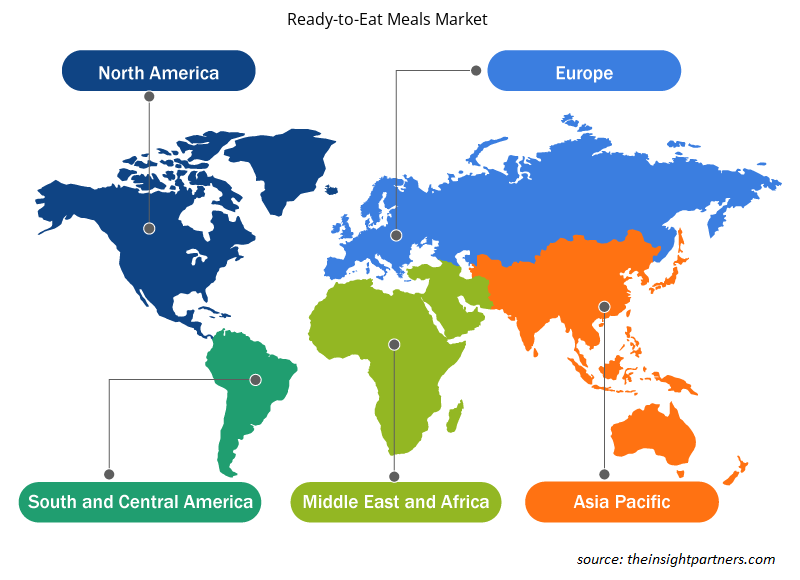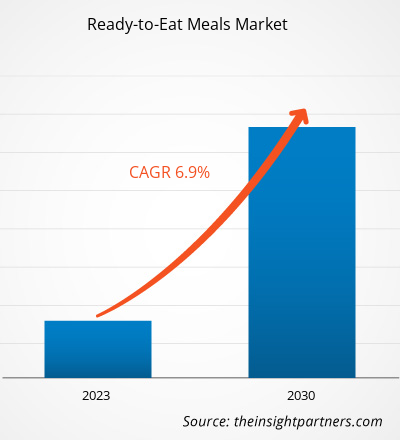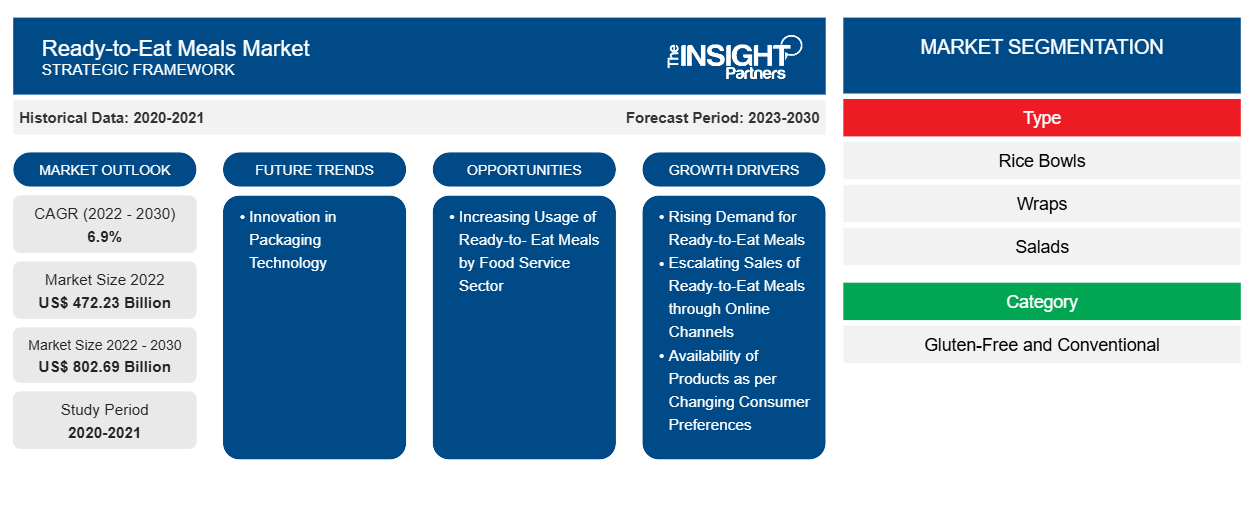[연구보고서] 즉석식품 시장은 2022년 472,231.63백만 달러에서 2030년 802,689.21백만 달러로 성장할 것으로 예상되며, 2022년에서 2030년까지 연평균 성장률 6.9%를 기록할 것으로 예상됩니다.
시장 통찰력 및 분석가 관점:
바로 먹을 수 있는 식사는 이동 중에도 번거로움 없이 먹을 수 있는 인스턴트 식품입니다. 샌드위치, 랩, 피자, 버거, 국수와 파스타, 카레와 그레이비, 부리또, 라이스 볼은 널리 소비되는 바로 먹을 수 있는 식사 중 일부입니다. 전 세계 사람들의 라이프스타일은 기업 부문의 성장, 이중 소득 가구의 증가, 연장된 근무 시간으로 인해 극적으로 바뀌었습니다. 사람들은 요리 시간과 노력을 피하기 위해 바로 먹을 수 있는 식사를 선호합니다. 이러한 요인은 글로벌 바로 먹을 수 있는 식사 시장의 성장에 상당히 기여했습니다.
카테고리에 따라, 즉석식품 시장은 글루텐 프리와 컨벤셔널로 분류됩니다. 이 지역에서 글루텐 불내증이 증가하고, 글루텐 프리 제품의 건강상 이점에 대한 인식이 높아지면서 글루텐 프리 즉석식품 수요를 견인하는 주요 요인이 되었습니다. 또한, 소비자들이 다양한 글루텐 프리 즉석식품 브랜드에 보다 포괄적으로 접근할 수 있게 됨에 따라, 이 카테고리는 앞으로 몇 년 동안 엄청난 성장을 목격할 것으로 예상됩니다.
귀하의 요구 사항에 맞게 이 보고서를 사용자 정의하세요
이 보고서의 일부 또는 국가 수준 분석, Excel 데이터 팩을 포함하여 모든 보고서에 대한 사용자 정의를 무료로 받을 수 있으며 신생 기업 및 대학을 위한 훌륭한 혜택과 할인 혜택을 이용할 수 있습니다.
- 이 보고서의 주요 시장 동향을 알아보세요.이 무료 샘플에는 시장 동향부터 추정 및 예측까지 다양한 데이터 분석이 포함됩니다.
성장 동인 및 과제:
고품질 편의식품의 소비는 식품 산업에서 가장 큰 트렌드 중 하나가 되었습니다. 즉석식품, 즉석식 식사, 냉동식품과 같은 편의식품은 소비자가 재료 쇼핑, 식사 준비 및 조리, 소비, 식사 후 활동과 관련된 시간과 노력을 절약할 수 있게 해줍니다. 편의성과 맛은 전 세계 소비자가 식품을 구매할 때 가장 원하는 속성입니다. "국제 식품 정보 위원회( IFIC )"의 식품 및 건강 설문 조사에 따르면 편의성은 밀레니얼 세대가 식품을 구매할 때 의 주요 동인입니다 . 동시에 맛은 베이비붐 세대에게 필수적입니다.
Amazon Fresh 및 Instacart 와 같은 슈퍼마켓 배달 서비스 와 Blue Apron과 같은 식사 키트 배달 회사는 편의성과 품질에 대한 선호도가 높아짐에 따라 혜택을 받았습니다. 게다가 진화된 냉장 공급망이 존재하기 때문에 RTE 식품 취급이 쉽다고 생각합니다. 이러한 요인은 전 세계적으로 편의 식품에 대한 수요를 증가시킵니다.
전 세계적으로 소규모 가구와 이중 소득 가정이 늘어나면서 즉석식품과 같은 편의 식품이 인기를 얻고 있습니다. 바쁜 업무 일정으로 인해 밀레니얼 세대는 시간을 효율적으로 사용하고 지루한 작업을 피하는 것을 선호합니다. 즉석식품은 가공되고 보존 기술을 사용하여 제품의 유통기한을 연장합니다. 식품 준비에 드는 시간과 노력을 절약하고 보관 및 운송이 편리해지면서 수요가 더욱 증가했습니다. 국제식품정보위원회의 "2020년 식품 및 건강 설문 조사"에 따르면 1,011명의 미국인(18~80세)을 대상으로 한 조사에서 소비자의 19%가 식료품 저장실이나 냉동고에서 미리 만든 식사를 더 많이 먹었습니다.
2020 Eating Better의 Ready Meals Snapshot Survey에 따르면, 영국 성인의 88%가 바로 먹을 수 있는 아침과 저녁 식사 또는 바로 조리할 수 있는 음식을 먹습니다. 5명 중 2명은 매주 포장된 바로 먹을 수 있는 식사를 먹습니다. 따라서 시간과 노력을 절약하기 위해 바로 먹을 수 있는 식사와 같은 편의 식품에 대한 수요가 증가하면서 전 세계적으로 바로 먹을 수 있는 식사 시장이 성장하고 있습니다.
미국에서 북미에서 일하는 전문가 수가 급증하고 있습니다.캐나다 고용 및 사회 개발부( ESDC )에 따르면, 캐나다에서 여성과 남성의 노동력 참여율은 2022년에 88.142%로 보고되었으며, 2021년의 이전 수치인 87.075%에서 증가했습니다.근로 인구의 증가로 인해 바로 먹을 수 있는 식사와 같은 편의 식품에 대한 수요가 더욱 강력해졌으며, 이는 시간과 노력을 절약하는 데 도움이 됩니다.슈퍼마켓 및 하이퍼마켓, 온라인 소매와 같은 확립된 유통 채널 덕분에 이러한 제품을 이 지역의 다양한 가정에서 구입할 수 있게 되었고, 북미의 바로 먹을 수 있는 식사 시장을 주도했습니다.온라인 쇼핑 플랫폼은 COVID-19 팬데믹 동안 엄청난 인기를 얻었습니다. 미국 외국 농업 서비스 에 따르면 , 2022년 캐나다 소매 식품 산업은 집중적인 컴백을 보였으며, 총 매출은 약 295억 달러에 달해 2021년 대비 20.9% 증가했습니다. 따라서 캐나다 소매 산업은 매우 다양화되어 있으며, 즉석식품 시장에 새로운 기회를 제공할 것으로 예상됩니다. 따라서 위에서 언급한 모든 요인이 즉석식품 시장의 성장을 촉진하고 있습니다.
보고서 세분화 및 범위:
"글로벌 레디투잇 밀스 마켓"은 유형, 카테고리, 최종 사용자, 지역에 따라 세분화됩니다. 유형에 따라 시장은 라이스 볼, 랩, 샐러드, 부리또, 그레이비와 카레, 국수와 파스타, 피자, 수프와 스튜, 육류 메인 요리 , 버거, 샌드위치 등으로 세분화됩니다. 국수와 파스타 부문은 글로벌 레디투잇 밀스 시장에서 가장 큰 점유율을 차지했습니다. 지역에 따라 레디투잇 밀스 시장은 북미(미국, 캐나다, 멕시코), 유럽(독일, 프랑스, 이탈리아, 영국, 러시아, 유럽의 나머지 지역), 아시아 태평양(호주, 중국, 일본, 인도, 한국, 아시아 태평양의 나머지 지역), 중동 및 아프리카(남아프리카, 사우디 아라비아, UAE , 중동 및 아프리카의 나머지 지역), 남중미(브라질, 칠레, 남중미의 나머지 지역)로 세분화됩니다.
세그먼트 분석:
유형에 따라 즉석식품 시장은 라이스 볼, 랩, 샐러드, 부리또, 그레이비와 카레, 국수와 파스타, 피자, 수프와 스튜, 육류 메인 요리 , 버거 등으로 세분화됩니다. 국수와 파스타 부문은 2022년 즉석식품 시장에서 가장 큰 점유율을 차지했습니다. 샐러드 부문은 예측 기간 동안 더 높은 CAGR을 기록할 것으로 예상됩니다 . 즉석식품 파스타는 스파게티, 펜네 , 페투치네, 마카로니 등 다양한 유형으로 제공됩니다. 파스타에는 새우 , 미트볼, 닭고기, 식물성 단백질 공급원과 같은 단백질 공급원이 포함됩니다. 포장된 파스타는 빠르게 제공되도록 설계되었으며 최소한의 조리가 필요합니다. 즉석식품 파스타는 단일 제공 용기에 담겨 제공되므로 분량 조절과 재가열이 더 쉽습니다. 변화하는 음식 소비 습관, 바쁜 라이프스타일, 다양한 문화에 대한 노출, 다양한 요리와 편의 식품에 대한 수요 증가는 바로 먹을 수 있는 국수에 대한 수요를 견인하는 주요 요인입니다. 제조업체는 비건, 글루텐 프리 또는 유기농 국수와 같이 여러 범주에서 바로 먹을 수 있는 국수를 출시하여 더욱 편리한 식사 옵션이 되었습니다.
지역 분석:
바로 먹을 수 있는 식사 시장은 북미, 유럽, 아시아 태평양, 남미 및 중미, 중동 및 아프리카의 5개 주요 지역으로 세분화됩니다. 글로벌 바로 먹을 수 있는 식사 시장은 아시아 태평양 지역이 주도했으며 2022년에는 약 1,500억 달러로 추산되었습니다. 아시아 태평양 지역의 바로 먹을 수 있는 식사 시장은 호주, 중국, 인도, 일본, 한국, 그리고 나머지 아시아 태평양 지역으로 세분화됩니다. 중산층 인구의 증가하는 도시화와 가처분 소득은 버거, 샌드위치, 국수, 파스타, 피자를 포함한 바로 먹을 수 있는 식사에 대한 수요를 촉진합니다. 국제 노동 기구(ILO)에 따르면 아시아 태평양 국가의 총 소득은 2021년에 3.5% 증가했으며, 그 중 중국은 2021년에 0.3%, 2022년 상반기에 0.7%를 차지했습니다.
중앙아시아와 서아시아에서 총 소득은 12.4% 증가했습니다. 직장인들은 가처분 소득 증가, 시간 제약, 바쁜 업무 일정으로 인해 밥그릇, 랩, 샐러드, 롤, 그레이비와 카레, 국수와 파스타, 피자, 수프와 스튜와 같은 편리한 음식 옵션을 선호합니다.
기회 측면에서 아시아 태평양의 즉석식품 시장은 혁신에 대한 상당한 잠재력을 가지고 있습니다. 제조업체는 소비자의 다양한 취향과 선호도에 맞춰 새로운 맛, 재료 및 조리 기술을 도입하기 위해 제품 개발에 집중합니다. 게다가 맞춤형 식사 솔루션으로 학교, 대학 및 기업 사무실과 같은 기관을 타겟팅하면 아시아 태평양 즉석식품 시장에서 운영되는 기업에 새로운 수익원이 창출됩니다.
서구적 라이프스타일과 요리의 영향은 아시아 태평양 지역에서 즉석식품 제품에 대한 수요를 높이는 또 다른 주요 요인입니다. 그러나 소비자의 가격 민감성은 아시아 태평양 지역에서 즉석식품 산업의 발전에 상당한 과제를 안겨줍니다.
산업 발전 및 미래 기회:
글로벌 즉석식품 시장에서 활동하는 주요 기업이 취한 다양한 이니셔티브는 아래와 같습니다.
- 2020년 12월, 네슬레 SA는 중국에서 Harvest Gourmet의 식물성 바로 먹을 수 있는 식사 제품 라인을 출시했습니다. 이 제품 라인에는 버거, 소시지, 너겟, 다진 고기, 쿵파오 치킨, 끓인 미트볼, 돼지 고기 배, 매콤한 웍과 같은 식물성 옵션이 포함됩니다.
- 2021년 6월, 미국 식품 가공업체 '타이슨푸드(Tyson Foods, Inc.)'가 아시아 태평양 지역에서 식물성 즉석식품을 출시했습니다.
- 2020년 12월, Nestle SA의 자회사인 즉석식품 배달 서비스인 Freshly Inc.가 즉석식품 제품을 출시했습니다. 이 제품은 글루텐이 없고 클린 라벨이며, 통식품 재료로 만들어졌습니다.
바로 먹을 수 있는 식사 시장 지역 통찰력
Insight Partners의 분석가들은 예측 기간 동안 바로 먹을 수 있는 식사 시장에 영향을 미치는 지역적 추세와 요인을 철저히 설명했습니다. 이 섹션에서는 북미, 유럽, 아시아 태평양, 중동 및 아프리카, 남미 및 중미의 바로 먹을 수 있는 식사 시장 세그먼트와 지리에 대해서도 설명합니다.

- 바로 먹을 수 있는 식사 시장에 대한 지역별 특정 데이터 얻기
바로 먹을 수 있는 식사 시장 보고서 범위
| 보고서 속성 | 세부 |
|---|---|
| 2022년 시장 규모 | 4722억 3천만 달러 |
| 2030년까지 시장 규모 | 8,026억 9,000만 달러 |
| 글로벌 CAGR (2022-2030) | 6.9% |
| 역사적 데이터 | 2020-2021 |
| 예측 기간 | 2023-2030 |
| 다루는 세그먼트 | 유형별로
|
| 포함된 지역 및 국가 | 북아메리카
|
| 시장 선도 기업 및 주요 회사 프로필 |
|
바로 먹을 수 있는 식사 시장 참여자 밀도: 비즈니스 역학에 미치는 영향 이해
바로 먹을 수 있는 식사 시장 시장은 소비자 선호도의 변화, 기술 발전, 제품의 이점에 대한 인식 증가와 같은 요인으로 인해 최종 사용자 수요가 증가함에 따라 빠르게 성장하고 있습니다. 수요가 증가함에 따라 기업은 제품을 확장하고, 소비자의 요구를 충족하기 위해 혁신하고, 새로운 트렌드를 활용하여 시장 성장을 더욱 촉진하고 있습니다.
시장 참여자 밀도는 특정 시장이나 산업 내에서 운영되는 회사나 기업의 분포를 말합니다. 주어진 시장 공간에 얼마나 많은 경쟁자(시장 참여자)가 존재하는지 그 규모나 전체 시장 가치에 비해 나타냅니다.
즉석식품 시장에서 운영되는 주요 회사는 다음과 같습니다.
- 타이슨푸드 주식회사
- SK칠드푸드
- 프레쉬 그릴 푸드 유한회사
- 댄디 샌드위치 주식회사
- 테일러 팜스
면책 조항 : 위에 나열된 회사는 어떤 특별한 순서에 따라 순위가 매겨지지 않았습니다.

- 바로 먹을 수 있는 식사 시장 주요 업체 개요 알아보기
COVID-19 팬데믹 영향:
COVID-19 팬데믹은 다양한 국가의 경제와 산업에 영향을 미쳤습니다. 북미, 유럽, 아시아 태평양(APAC), 남미 및 중미, 중동 및 아프리카(MEA)의 주요 국가에서 봉쇄, 여행 금지 및 사업 중단은 식품 및 음료를 포함한 다양한 산업의 성장에 부정적인 영향을 미쳤습니다. 제조 단위의 폐쇄는 글로벌 공급망, 제조 활동, 배송 일정 및 다양한 필수 및 비필수 제품의 판매를 방해했습니다. 다양한 회사에서 2020년에 제품 배송이 지연되고 향후 제품 판매가 침체될 가능성이 있다고 발표했습니다. 또한 유럽, 아시아 태평양 및 북미의 다양한 정부가 국제 여행에 대한 금지 조치를 취하면서 회사는 협력 및 파트너십 계획을 일시적으로 보류해야 했습니다. 게다가 봉쇄로 인한 도축장 폐쇄는 시장 성장에 부정적인 영향을 미쳤습니다. 이러한 모든 요인이 2020년과 2021년 초에 식품 및 음료 산업을 방해하여 바로 먹을 수 있는 식사 시장의 성장을 제한했습니다.
경쟁 환경 및 주요 회사:
Tyson Foods Inc., SK Chilled Foods, Fresh Grill Foods LLC, Dandee Sandwich Co., Taylor Farms, Calavo Growers Inc., Hearthside Food Solutions LLC, EA Sween, FreshRealm, TripleSticks는 글로벌 즉석식품 시장에서 활동하는 대표적인 기업입니다. 이러한 즉석식품 제조업체는 혁신적인 기능을 갖춘 최첨단 추출 솔루션을 제공하여 소비자에게 뛰어난 경험을 제공합니다.
- 과거 분석(2년), 기준 연도, CAGR을 포함한 예측(7년)
- PEST 및 SWOT 분석
- 시장 규모 가치/거래량 - 글로벌, 지역, 국가
- 산업 및 경쟁 환경
- Excel 데이터세트
최근 보고서
사용 후기
구매 이유
- 정보에 기반한 의사 결정
- 시장 역학 이해
- 경쟁 분석
- 고객 인사이트
- 시장 예측
- 위험 완화
- 전략 기획
- 투자 타당성 분석
- 신흥 시장 파악
- 마케팅 전략 강화
- 운영 효율성 향상
- 규제 동향에 발맞춰 대응





















 무료 샘플 받기 - 즉석식품 시장
무료 샘플 받기 - 즉석식품 시장